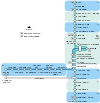Manchester Metrolink
| Manchester Metrolink | |||||||||||||||||||||||||||||||||||||||||||||||||||||||||||||||||||||||||||||||||||||||||||||||||||||||||||||||||||||||||||||||||||||||||||||||||||||||||||||||||||||||||||||||||||||||||||||||||||||||||||||||||||||||||||||||||||||||||||||||||||||||
|---|---|---|---|---|---|---|---|---|---|---|---|---|---|---|---|---|---|---|---|---|---|---|---|---|---|---|---|---|---|---|---|---|---|---|---|---|---|---|---|---|---|---|---|---|---|---|---|---|---|---|---|---|---|---|---|---|---|---|---|---|---|---|---|---|---|---|---|---|---|---|---|---|---|---|---|---|---|---|---|---|---|---|---|---|---|---|---|---|---|---|---|---|---|---|---|---|---|---|---|---|---|---|---|---|---|---|---|---|---|---|---|---|---|---|---|---|---|---|---|---|---|---|---|---|---|---|---|---|---|---|---|---|---|---|---|---|---|---|---|---|---|---|---|---|---|---|---|---|---|---|---|---|---|---|---|---|---|---|---|---|---|---|---|---|---|---|---|---|---|---|---|---|---|---|---|---|---|---|---|---|---|---|---|---|---|---|---|---|---|---|---|---|---|---|---|---|---|---|---|---|---|---|---|---|---|---|---|---|---|---|---|---|---|---|---|---|---|---|---|---|---|---|---|---|---|---|---|---|---|---|---|---|---|---|---|---|---|---|---|---|---|---|---|---|---|---|---|
 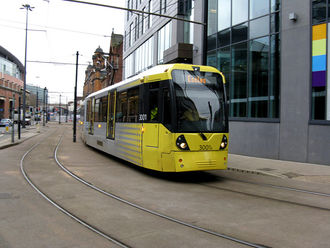 |
|||||||||||||||||||||||||||||||||||||||||||||||||||||||||||||||||||||||||||||||||||||||||||||||||||||||||||||||||||||||||||||||||||||||||||||||||||||||||||||||||||||||||||||||||||||||||||||||||||||||||||||||||||||||||||||||||||||||||||||||||||||||
| Info | |||||||||||||||||||||||||||||||||||||||||||||||||||||||||||||||||||||||||||||||||||||||||||||||||||||||||||||||||||||||||||||||||||||||||||||||||||||||||||||||||||||||||||||||||||||||||||||||||||||||||||||||||||||||||||||||||||||||||||||||||||||||
| Owner | GMPTE | ||||||||||||||||||||||||||||||||||||||||||||||||||||||||||||||||||||||||||||||||||||||||||||||||||||||||||||||||||||||||||||||||||||||||||||||||||||||||||||||||||||||||||||||||||||||||||||||||||||||||||||||||||||||||||||||||||||||||||||||||||||||
| Locale | Greater Manchester | ||||||||||||||||||||||||||||||||||||||||||||||||||||||||||||||||||||||||||||||||||||||||||||||||||||||||||||||||||||||||||||||||||||||||||||||||||||||||||||||||||||||||||||||||||||||||||||||||||||||||||||||||||||||||||||||||||||||||||||||||||||||
| Transit type | Light rail | ||||||||||||||||||||||||||||||||||||||||||||||||||||||||||||||||||||||||||||||||||||||||||||||||||||||||||||||||||||||||||||||||||||||||||||||||||||||||||||||||||||||||||||||||||||||||||||||||||||||||||||||||||||||||||||||||||||||||||||||||||||||
| Number of lines | 3 (soon to be 7) | ||||||||||||||||||||||||||||||||||||||||||||||||||||||||||||||||||||||||||||||||||||||||||||||||||||||||||||||||||||||||||||||||||||||||||||||||||||||||||||||||||||||||||||||||||||||||||||||||||||||||||||||||||||||||||||||||||||||||||||||||||||||
| Number of stations | 37 | ||||||||||||||||||||||||||||||||||||||||||||||||||||||||||||||||||||||||||||||||||||||||||||||||||||||||||||||||||||||||||||||||||||||||||||||||||||||||||||||||||||||||||||||||||||||||||||||||||||||||||||||||||||||||||||||||||||||||||||||||||||||
| Daily ridership | 56,000 | ||||||||||||||||||||||||||||||||||||||||||||||||||||||||||||||||||||||||||||||||||||||||||||||||||||||||||||||||||||||||||||||||||||||||||||||||||||||||||||||||||||||||||||||||||||||||||||||||||||||||||||||||||||||||||||||||||||||||||||||||||||||
| Headquarters | Metrolink House, Queens Road, Manchester, England |
||||||||||||||||||||||||||||||||||||||||||||||||||||||||||||||||||||||||||||||||||||||||||||||||||||||||||||||||||||||||||||||||||||||||||||||||||||||||||||||||||||||||||||||||||||||||||||||||||||||||||||||||||||||||||||||||||||||||||||||||||||||
| Operation | |||||||||||||||||||||||||||||||||||||||||||||||||||||||||||||||||||||||||||||||||||||||||||||||||||||||||||||||||||||||||||||||||||||||||||||||||||||||||||||||||||||||||||||||||||||||||||||||||||||||||||||||||||||||||||||||||||||||||||||||||||||||
| Began operation | 6 April 1992 | ||||||||||||||||||||||||||||||||||||||||||||||||||||||||||||||||||||||||||||||||||||||||||||||||||||||||||||||||||||||||||||||||||||||||||||||||||||||||||||||||||||||||||||||||||||||||||||||||||||||||||||||||||||||||||||||||||||||||||||||||||||||
| Operator(s) | Stagecoach Group | ||||||||||||||||||||||||||||||||||||||||||||||||||||||||||||||||||||||||||||||||||||||||||||||||||||||||||||||||||||||||||||||||||||||||||||||||||||||||||||||||||||||||||||||||||||||||||||||||||||||||||||||||||||||||||||||||||||||||||||||||||||||
| Number of vehicles | 26 T68 6 T68a 21 M5000 (to be 62) |
||||||||||||||||||||||||||||||||||||||||||||||||||||||||||||||||||||||||||||||||||||||||||||||||||||||||||||||||||||||||||||||||||||||||||||||||||||||||||||||||||||||||||||||||||||||||||||||||||||||||||||||||||||||||||||||||||||||||||||||||||||||
| Train length | 30 m (98 ft) | ||||||||||||||||||||||||||||||||||||||||||||||||||||||||||||||||||||||||||||||||||||||||||||||||||||||||||||||||||||||||||||||||||||||||||||||||||||||||||||||||||||||||||||||||||||||||||||||||||||||||||||||||||||||||||||||||||||||||||||||||||||||
| Technical | |||||||||||||||||||||||||||||||||||||||||||||||||||||||||||||||||||||||||||||||||||||||||||||||||||||||||||||||||||||||||||||||||||||||||||||||||||||||||||||||||||||||||||||||||||||||||||||||||||||||||||||||||||||||||||||||||||||||||||||||||||||||
| System length | 37 km (23 mi) | ||||||||||||||||||||||||||||||||||||||||||||||||||||||||||||||||||||||||||||||||||||||||||||||||||||||||||||||||||||||||||||||||||||||||||||||||||||||||||||||||||||||||||||||||||||||||||||||||||||||||||||||||||||||||||||||||||||||||||||||||||||||
| Track gauge | Standard gauge | ||||||||||||||||||||||||||||||||||||||||||||||||||||||||||||||||||||||||||||||||||||||||||||||||||||||||||||||||||||||||||||||||||||||||||||||||||||||||||||||||||||||||||||||||||||||||||||||||||||||||||||||||||||||||||||||||||||||||||||||||||||||
| Minimum radius of curvature | 25 m (82 ft)[1] | ||||||||||||||||||||||||||||||||||||||||||||||||||||||||||||||||||||||||||||||||||||||||||||||||||||||||||||||||||||||||||||||||||||||||||||||||||||||||||||||||||||||||||||||||||||||||||||||||||||||||||||||||||||||||||||||||||||||||||||||||||||||
| Average speed | 48 km/h (30 mph) | ||||||||||||||||||||||||||||||||||||||||||||||||||||||||||||||||||||||||||||||||||||||||||||||||||||||||||||||||||||||||||||||||||||||||||||||||||||||||||||||||||||||||||||||||||||||||||||||||||||||||||||||||||||||||||||||||||||||||||||||||||||||
| Top speed | 80 km/h (50 mph) | ||||||||||||||||||||||||||||||||||||||||||||||||||||||||||||||||||||||||||||||||||||||||||||||||||||||||||||||||||||||||||||||||||||||||||||||||||||||||||||||||||||||||||||||||||||||||||||||||||||||||||||||||||||||||||||||||||||||||||||||||||||||
|
|||||||||||||||||||||||||||||||||||||||||||||||||||||||||||||||||||||||||||||||||||||||||||||||||||||||||||||||||||||||||||||||||||||||||||||||||||||||||||||||||||||||||||||||||||||||||||||||||||||||||||||||||||||||||||||||||||||||||||||||||||||||
Manchester Metrolink[2] (which operates as Metrolink) is a light rail system in Greater Manchester, England. It consists of three lines which converge in Manchester city centre and serve the surrounding towns of Bury, Altrincham and Eccles. The system is owned by the Greater Manchester Passenger Transport Executive (GMPTE) and operated under contract by Stagecoach Group.
Metrolink trams run on streets in the city centre, but most of the routes in the suburbs use former heavy rail lines. The Eccles line also runs on the streets alot. Several extensions to the system are currently under construction or have been proposed. Late in 2008 works started extending the system to East Didsbury, Ashton-under-Lyne, Oldham, Rochdale, Mediacity:uk and Manchester Airport. The expansions will increase the system's length from 37 to 97 km (23 to 60 mi) with at least 99 stops. On 13 May 2009 funding was secured for phase 3b, with a small rise in council taxes, and work will start from late 2009.[3][4]. Further potential extensions to Stockport and the Trafford Centre are envisaged, subject to funding.
Contents |
History
The need for a light rail system in Manchester was born out of a desire to link the two main railway stations, Piccadilly and Victoria. In the late 1960s and early 1970s there were plans for a "Picc-Vic tunnel" to carry main-line trains under the city centre,[5] but this proposal was abandoned because of excessive cost.
Plans for a light rail system in Manchester were first drawn up in 1984, consisting of three lines radiating from the city centre with an estimated cost of £42.5million[6] The plans were revised in 1987, and a trial using a prototype Docklands Light Railway train was carried out on a freight-only line.[7].
Authority to begin construction was granted in January 1988. This involved closing the heavy rail lines from Bury to Victoria (which was electrified using a non-standard and life-expired system) and from Altrincham to Manchester Picadilly for conversion, and a new route through the city centre streets. The line opened between Bury and Victoria in April 1992; the full system was operational from July that year.
A second phase, which extended the network to Eccles, was opened to Salford Quays (Broadway stop) in December 1999, and through to Eccles on the 18 of July 2000.
Operator
Metrolink is run as a public-private partnership between GMPTE and private transport firms. The system has been operated and maintained since 2007 by Stagecoach Metrolink—part of the Stagecoach Group—under a 10-year fixed-term management contract, which will run until July 2017.[8][9] Stagecoach also operate another British light rail system, Sheffield Supertram.
Routes and stations
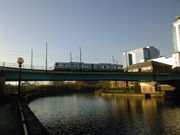
Monday to Saturday service:
- Bury – Altrincham - every 12 minutes (daytime only)
- Piccadilly – Bury - every 12 minutes
- Piccadilly – Altrincham - every 12 minutes
- Piccadilly – Eccles - every 12 minutes
The combined Monday-Saturday daytime frequency on the Bury and Altrincham routes is every 6 minutes.
Sunday and Bank Holiday service:
- Piccadilly – Bury - every 12 minutes 1000-1700, every 15 minutes at other times
- Piccadilly – Altrincham - every 12 minutes 1000-1700, every 15 minutes at other times
- Piccadilly – Eccles - every 12 minutes 1000-1700, every 15 minutes at other times
The current route length is:
| Phase 1 | |
|---|---|
| Bury – Victoria | 15.9 km (9.9 mi) |
| Victoria – G-Mex | 1.9 km (1.2 mi) |
| Spur to Piccadilly station | 0.4 km (0.25 mi) |
| G-Mex – Altrincham | 12.2 km (7.6 mi) |
| Phase 2 | |
| Cornbrook – Broadway | 3.1 km (1.9 mi) |
| Broadway – Eccles | 3.9 km (2.4 mi) |
Rail interchanges on Metrolink include Piccadilly, Victoria, G-Mex (for Deansgate), Altrincham and Navigation Road. Eccles is also available for interchange via a 400-m walk. Major bus interchanges are at Bury, Victoria, Shudehill, Piccadilly Gardens, Altrincham and Eccles. In December 2007 there were 37 Metrolink stops: 17 former British Rail stations on the Phase 1 lines to Altrincham and Bury, 17 new stops on the Phase 1 lines in the city centre and on the Phase 2 line to Eccles, and 3 shared main line stations (Altrincham, Piccadilly and Victoria).
The Metrolink depot is south of Queen's Road (Cheetham Hill, M8) on the western side of the Bury line, between Victoria and Woodlands Road. The depot connections face Bury. Queens Road staff halt serves the depot.[10] This facility will not be able to handle the expanded network, so GMPTE has obtained a site for a second depot near Old Trafford.[11] Work on this site, alongside the track between Trafford Bar and Old Trafford, commenced in early 2009 with the demolition of the remaining buildings on the site. Commencing shortly after the delivery of 3013 caused Queens Road to pass its newly expanded stabling capacity new trams are being stored at the still under construction Old Trafford Depot until the new extensions open, as of June 2010 the depot can store upto twenty trams under live wires of its planned forty capacity, the 2002 Transport Works Act order granting permission for the depot specified that no more than 55 trams could use the site at any one time on environmental grounds. [12]
On 15 January 2010, A report was issued by GMITA (Greater Manchester Integrated Transport Authority) proposing the possible closure of Mosley Street station due to operational difficulties including the annual maintenance cost of retractable steps on the trams to access the profiled platform, the cramped location being unsuitable for full length platform conversion and tram congestion affecting the nearby Piccadilly delta junction when frequency is increased.[13]
| Bury Line | Altrincham Line | Eccles Line |
|---|---|---|
(*)=Planned (#)=Planned to close |
The line through Navigation Road is single track. |
|
Fares and usage

Fares are charged according on the number of fare zones travelled through, and whether travel is in the peak period - before 0930 on weekdays (except public holidays).
Tickets are purchased from machines at each stop. Single journeys must be completed within 90 minutes, return journeys the same day. It is possible to purchase tickets from the machines for travel all day, for groups, or all weekend. Some ticket machines accept only coins, others also accept banknotes and give a maximum of £7 in change. Train users travelling into the city centre from stations in Greater Manchester are able to use the Metrolink in the central zone for nothing. These train tickets can be used between Victoria, Shudehill, Market Street, Piccadilly Gardens, Piccadilly, Mosley Street, St Peter's Square and G-Mex.[14] Free tram rides also extend to stations outside Greater Manchester between Ashley and Northwich. Standard rail tickets for stations between Altrincham and Mouldsworth are valid on Metrolink services on Sundays only. This was due to no trains running between Altrincham and Manchester on a Sunday between 1992 and December 2008, due to a GMPTE budgeting crisis in 1992 after which the service was not reinstated. A two-hourly Sunday train service between Altrincham and Manchester has since been resumed, but tickets remain valid on Sundays.[15] Metrolink is in the process of rolling out new ticketing stock which is similar to the systems in use with National Rail services. This includes the introduction of stronger credit card sized tickets with magnetic strip encoding.
All Metrolink tickets must be purchased before travel. A "standard fare" of £100 is charged for travelling without a valid ticket (Must be paid within 21 days of issue) (Reduced to £50 if paid within 14 days) [16]. Metrolink is policed by the Greater Manchester Police including Police Community Support Officers. An initiative by Greater Manchester Police, which saw around 15 officers routinely patrolling the tram network, was stopped due to lack of funds. On-board ticket checks are done by Carlisle Security on behalf of the GMPTE.
Metrolink carried 18.8 million passengers in 2004, compared to 7.5 million who used the Bury and Altrincham rail services before Metrolink. According to Metrolink sources, at least two million fewer car journeys have been made each year along the tram route. Metrolink has become something of a victim of its own popularity. Many services are extremely busy, especially at peak times at the city centre stations, and fares have risen at a rate far above that of inflation. In the first two years of Metrolink operation, peak hour patronage was well below expected levels, but off-peak patronage exceeded expectations. Metrolink reacted by reducing peak fares which improved loadings.
Vehicles
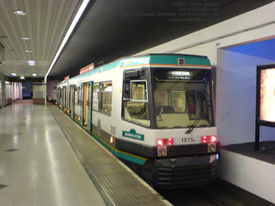
T-68
The original vehicles operated on the Metrolink network since 1991 are T-68 trams built by the Italian manufacturer AnsaldoBreda. In 1999 the same company supplied six T-68a trams for operation on the Eccles extension. In December 2007 the Metrolink fleet consisted of 26 T-68 vehicles numbered in the 1000 series, and six T68a vehicles numbered in the 2000 series.
The trams normally operate singly, except during the rush hours when there are a few double trams along the Bury–Altrincham route. The trams consist of two units joined by an articulated section, with four doors per side. They are 30 m long and bi-directional with cabs at both ends.[17] The front and rear bogies are powered, with two 750 V, 105 kW motors per bogie. The third bogie, under the articulation, is not powered. The maximum speed is 112 km/h (70 mph), however 48 km/h (30 mph) is the maximum speed allowed for street running. There are 83 seats in each vehicle (plus four folding seats) and the nominal capacity is 200 passengers (250 maximum). Up to four trams can be worked in multiple, but the platform length on the Eccles line and city centre routes allow for a double unit only. Although the former heavy rail stations on the Bury and Altrincham lines can accept a triple or quadruple tram, each platform's public area is currently shorter than its full length.
M5000
As part of the "Big Bang" network extension project, the Metrolink fleet is being expanded with the introduction of new Flexity Swift high-floor trams, built by Bombardier Transportation.
In April 2007 eight Flexity Swift LRVs were ordered, designated 'M5000', similar to the K5000 series used in the German cities of Cologne and Bonn, and similar to the low-floor models used by London's Tramlink. This initial order was quickly followed by additional orders taking the present order tally to 48 of which 21 have been delivered. An order for 14 additional trams, 12 for the Airport line and one each for the Oldham and Rochdale town centre extensions is close to being signed [18]</ref>. Each tram is 28.4m long, and has 52 standard seats with a further 8 'perch' seats.
| Class | Image | Top speed | Number | Built | |
|---|---|---|---|---|---|
| mph | km/h | ||||
| T-68 |  |
50 | 80 | 26 | 1991–1992 |
| T-68a |  |
50 | 80 | 6 | 1999 |
| M5000 |  |
50 | 80 | 62 (on order) | 2008–2011 |
Future
Mediacity:uk extension

The extension of the network to Mediacity:uk in Salford Quays is under development. Construction on the 400 m (440 yd) spur off the Eccles line was due to start in spring 2009. The Transport and Works application was approved in May 2009.[19]
It is planned to open the new line in summer 2010.[20]
Phase 3
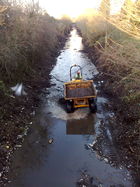
Phase 3 is an ambitious expansion programme that will see trams running to Oldham, Rochdale, Ashton-under-Lyne, Wythenshawe and Manchester Airport.[21] It has been dubbed the "Big Bang" on account of the size of the planned extensions.[22]
Expansion of the Metrolink network has been promoted since the 1980s, but proposals have had mixed fortunes. In 2000, a £500 million expansion of Metrolink was announced by the Government, promising extensions to Oldham, Rochdale, Ashton-under-Lyne, Wythenshawe and Manchester Airport.[23] These plans were later cancelled due to increasing costs.[24]
Phase 3 was eventually split into two more phases due to funding constraints, known as Phase 3a and Phase 3b. In December 2004 the government announced that £520 million would be authorised for Phase 3a. Phase 3a was given the go-ahead by the Department for Transport in July 2006, with a £300m funding gap expected to be met by a loan.[25] Funding for Phase 3b was tied in with the Greater Manchester Transport Innovation Fund; following the rejection of congestion charging in Manchester in a 2008 referendum, councils grouped together and agreed a way to raise the capital through loans, council tax rises and the government releasing future funding.[26] In May 2009, a revival of Phase 3 was announced, with plans to complete both phases of the "Big Bang" as part of one project, funded by national and local government.[3]
| East Manchester Line | South Manchester Line | Oldham & Rochdale Line |
|---|---|---|
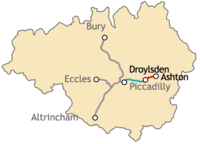 |
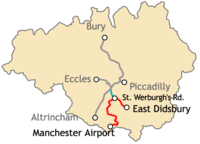 |
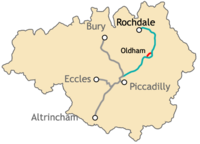 |
|
Phase 3a:
Phase 3b:
|
Phase 3a:
Phase 3b:
|
Phase 3a:
Phase 3b:
|
| East Manchester Line (Spring 2012 — Summer 2013 ) |
South Manchester Line (Spring 2011 — 2016) |
Oldham & Rochdale Line (Spring 2011 — 2014) |
|
East Didsbury Line
(#)= Planned to close
|
|
Phase 3a
| Manchester Metrolink Proposed Extensions (Phase 3a) |
|||||||||||||||||||||||||||||||||||||||||||||||||||||||||||||||||||||||||||||||||||||||||||||||||||||||||||||||||||||||||||||||||||||||||||||||||||||||||||||||||||||||||||||||||||||||||||||||||||||||||||||||||||||||||||||||||||||||||||||||||||||||||||||||||||||||||||||||||||||||||||||||||||||||||||||||||||||||||||||||||||||||||||||||||||||||||||||||||
|---|---|---|---|---|---|---|---|---|---|---|---|---|---|---|---|---|---|---|---|---|---|---|---|---|---|---|---|---|---|---|---|---|---|---|---|---|---|---|---|---|---|---|---|---|---|---|---|---|---|---|---|---|---|---|---|---|---|---|---|---|---|---|---|---|---|---|---|---|---|---|---|---|---|---|---|---|---|---|---|---|---|---|---|---|---|---|---|---|---|---|---|---|---|---|---|---|---|---|---|---|---|---|---|---|---|---|---|---|---|---|---|---|---|---|---|---|---|---|---|---|---|---|---|---|---|---|---|---|---|---|---|---|---|---|---|---|---|---|---|---|---|---|---|---|---|---|---|---|---|---|---|---|---|---|---|---|---|---|---|---|---|---|---|---|---|---|---|---|---|---|---|---|---|---|---|---|---|---|---|---|---|---|---|---|---|---|---|---|---|---|---|---|---|---|---|---|---|---|---|---|---|---|---|---|---|---|---|---|---|---|---|---|---|---|---|---|---|---|---|---|---|---|---|---|---|---|---|---|---|---|---|---|---|---|---|---|---|---|---|---|---|---|---|---|---|---|---|---|---|---|---|---|---|---|---|---|---|---|---|---|---|---|---|---|---|---|---|---|---|---|---|---|---|---|---|---|---|---|---|---|---|---|---|---|---|---|---|---|---|---|---|---|---|---|---|---|---|---|---|---|---|---|---|---|---|---|---|---|---|---|---|---|---|---|---|---|---|---|---|---|---|---|---|---|---|---|---|---|---|---|---|---|---|---|---|---|---|---|---|---|---|---|---|---|---|---|---|---|---|---|---|---|---|
|
|||||||||||||||||||||||||||||||||||||||||||||||||||||||||||||||||||||||||||||||||||||||||||||||||||||||||||||||||||||||||||||||||||||||||||||||||||||||||||||||||||||||||||||||||||||||||||||||||||||||||||||||||||||||||||||||||||||||||||||||||||||||||||||||||||||||||||||||||||||||||||||||||||||||||||||||||||||||||||||||||||||||||||||||||||||||||||||||||
Phase 3a will take over the existing heavy rail Oldham Loop Line to Oldham and Rochdale, and extensions to Droylsden and to St Werburgh's Road in Chorlton-cum-Hardy.[21]
Environmental surveys began in April 2008[28] and continued until the autumn. Several companies were short-listed to build the extensions[28] with the M-Pact Thales consortium, made up of Thales, Laing O'Rourke and GrantRail, being eventually picked[29] in spring 2008. The project's final cost was calculated at £575 million and was signed off in May 2008[29]. Construction started in 2009[30] and the new lines are hoped to become operational in 2011/12.
Phase 3b
Phase 3b will divert the Phase 3a Rochdale line into Oldham and Rochdale town centres, and extend the Droylsden line to Ashton-under-Lyne and the St Werburgh's Road line to East Didsbury and Manchester Airport.[21]
Phase 3b forms part of Greater Manchester's integrated transport strategy, which recommends a wide-ranging package of transport investment and traffic management measures. In July 2007 GMPTE and the Association of Greater Manchester Local Authorities (AGMA) submitted a bid to the Government's Transport Innovation Fund to secure the funding for this package which would have guaranteed the extensions to these destinations. The bid was put to a referendum and rejected by the residents of Greater Manchester. Following on from this, AGMA agreed a package to raise the capital needed for the extensions and work will begin in late 2009.
Two further Metrolink extensions were included in the 2007 GMPTE plans, serving Stockport and the Trafford Centre. The Trafford Centre line will continue from Pomona viaduct on the Eccles line, which has been built with the expansion in mind, and will have stops serving the Manchester United home ground at Old Trafford and Imperial War Museum North. These extensions are awaiting funding from private sector sources. Proposals to extend the East Didsbury line to Stockport town centre have not been approved by the Department for Transport and would therefore need to be deferred.
Concerns were raised in the original Phase 3 proposals regarding the continued reliance on a single route through the city centre, which could have become a bottleneck when the new extensions opened, with six or seven routes running over the same track. GMPTE has reacted to this by including an additional line, probably along Cross Street between GMex and Victoria with stops at the Manchester Town Hall and Arndale Shopping Centre. There will be a Bus Rapid Transit route developed linking the Metrolink service in the centre of Manchester with Leigh and Salford that will not be reached by the Phase 3b extensions.
The full proposal for the Metrolink extensions, including the additional city centre crossing and Trafford Park lines, and linking with new Bus Rapid Transit routes, would take the total cost of Phase 3 to an estimated £1.2 billion, requiring revenue from the government and local council taxes.[31]. AGMA commissioned a public referendum on the plans, including the congestion charge, and this concluded on 11 December 2008. Each borough representative agreed to vote in accordance with the public vote of their residents, with a minimum 7 to 3 majority of boroughs being required for the TIF proposal to proceed. 79% of the votes were cast against the plans[32].
The network including all immediately planned proposed expansions would increase in size from 37 kilometres (23.0 mi) with 37 stops to 97.3 kilometres (60.5 mi) with at least 105 stops, and carrying 70 million passengers per year.
| Project | Length | New trams required |
|---|---|---|
| Extension spur from Harbour City to Mediacity funded jointly by Peel Holdings and North West Development Agency, service to run between Cornbrook and Mediacity every 12 minutes | 0.4 km (0.25 mi) | 4 |
| Additional route across Manchester city centre between Central and Victoria | 2 km (1.2 mi) | Not yet known |
| Conversion of existing railway from Victoria to Oldham and Rochdale (plus some street running) | 25 km (16 mi) | 14 |
| Extension to Manchester Airport | 14.5 km (9.0 mi) | 12 |
| Extension to Ashton-under-Lyne | 10.2 km (6.3 mi) | 10 |
| Extension to East Didsbury | 7.2 km (4.5 mi) | 10 |
Phase 3 Big Bang revival, May 2009
At a meeting of AGMA (the Association of Greater Manchester Authorities), 12 May 2009, cross-party agreement was reached between representatives of all ten Greater Manchester authorities for an increase in Council Tax to cover a number of transport improvements.[3][33] The list of 10 schemes costing £1.4 billion includes some road and bus improvements but crucially for Metrolink fills the gap in funding left by the shortfall of the "3a" scheme.
The money is to be found by a combination of an increase in council tax (by approx £2 per year per council tax payer), contributions from Manchester Airport, increased revenue from passenger journeys and the early release of some central government money, previously earmarked for transport improvements in the conurbation.[34] The revived project was presented by the leader of Manchester City Council Sir Richard Leese as "a new plan" which had been drawn up after the failure of the Transport Innovation Fund referendum.[35]
Further projects
The Metrolink expansion proposals still not programmed following this announcement are:
- The Trafford Park/Trafford Centre line (dependent on private sector funding)[36]
- The full extension of the Didsbury line into Stockport Town centre.
- The completion of the Manchester Airport loop (dependent on private sector funding)
In addition, feasibility work is continuing on possible further Metrolink expansions beyond the Phase 3 network:
- Conversion of the Marple rail service to tram-train or Metrolink operation (dependent on funding from rail operation budgets)[37]
- Conversion of the Manchester-Atherton-Wigan line to tram-train or Metrolink operation.[38]
- Conversion of the Manchester-Bolton line to tram-train operation.[38]
- Possible linkages between Metrolink and the East Lancashire Railway[39]
A 2001 official document called the Greater Manchester Strategic Rail Study by the Department for Transport [40], also included several other potential routes that could be considered for potential Tram-Train or light rail working. This included an indicative route through inner South Manchester, which although drawn approximately on the reports map [41] as heading down Kingsway, a more likely, if technically difficult route, would be the Oxford Road-Wilmslow Road corridor. This route has also been raised as a potential Bus Rapid Transit route[42] where work is currently underway to restrict part of the route to buses only [43][44]. Princess Parkway was also considered at one point for the South Manchester (to Airport) route[45].
Criticism
Metrolink has been criticised for its concessionary fares policy, in particular for the student fare which does not extend to students over 19 years old[46] (A Railcard for 16-25s and full-time students over 25 is on sale for rail journeys [47] but is not valid for Metrolink journeys apart from through journeys from the National Rail network.) Metrolink is also unpopular with cyclists as bicycles are prohibited, unlike on heavy rail.[48] Metrolink has sought to cater for cyclists, folding cycles which are fully enclosed are permitted, it provides secure storage for cycles at every stop and a review is ongoing into risks, costs and attitudes to carrying cycles on trams. [49]
GMPTE has invested a lot of money converting popular heavy rail lines to light rail, which has attracted criticism.[50][51] Critics have remarked that while trams may run more frequently than heavy rail services, they are much smaller, meaning that there is actually less capacity on the Altrincham and Bury lines than in the 1980s.[50] They also point out that all trams call at every station, meaning that they are slower at reaching Manchester than some of the 1980s train services.[50] In their defence GMPTE points to the doubling of passenger numbers over a period of twenty years compared to their previous status as proof that the conversions are popular and increase usage. However, in context, most heavy rail services in to Manchester have seen increases in passenger numbers of around a third in the five years leading up to 2009.
The conversion of the Altrincham line has meant that trains from Knutsford, Northwich and Chester must take a longer route to Manchester through Stockport. In December 2008 that service had to be cut back further due to a shortage of paths through Stockport.[52] which resurfaced criticism about conversion of the Altrincham line.[51]
References
- ↑ http://www.lrta.org/Manchester/vehfact.html
- ↑ Department for Transport (2 February 2005). "Manchester Metrolink Working Group Minutes". dft.gov.uk. http://www.dft.gov.uk/foi/responses/2005/feb/manchestermetrolink/. Retrieved 1 November 2008.
- ↑ 3.0 3.1 3.2 "Tram line extension is approved". BBC News. 13 May 2009. http://news.bbc.co.uk/1/hi/england/manchester/8047020.stm. Retrieved 17 May 2009.
- ↑ "Metrolink: back on track?". BBC. 15 May 2009. http://www.bbc.co.uk/manchester/content/articles/2009/05/13/130509_metrolink_map_plan_b_feature.shtml. Retrieved 17 May 2009.
- ↑ SELNEC (October 1971), SELNEC Picc-Vic Line, SELNEC publicity brochure
- ↑ . Light Rapid Transit in Greater Manchester, GMPTE, 1984 - publicity brochure
- ↑ Link
- ↑ Stagecoach Group (29 May 2007). "Stagecoach signs Manchester Metrolink contract". Press release. http://www.stagecoachgroup.com/scg/media/press/pr2007/2007-05-29/. Retrieved 28 December 2008.
- ↑ "Stagecoach take over tram service". BBC News. 15 July 2007. http://news.bbc.co.uk/1/hi/england/manchester/6899507.stm. Retrieved 1 November 2008.
- ↑ "Bury line description". Light Rail Transit Association. http://www.lrta.org/Manchester/Bury_Line.html. Retrieved 20 December 2007.
- ↑ "New Metrolink depot". Light Rail Transit Association. http://www.lrta.org/Manchester/advance_works.html. Retrieved 20 December 2007.
- ↑ http://webarchive.nationalarchives.gov.uk/+/http://www.dft.gov.uk/pgr/twa/dl/archive/icationsfortheproposedgr5610.pdf
- ↑ http://www.gmita.gov.uk/download/2894/item_10_metrolink_mosley_street_stop
- ↑ "Free tram rides for Greater Manchester's train passengers". GMPTE. 9 August 2007. http://www.gmpte.com/news.cfm?news_id=5521685. Retrieved 10 July 2008.
- ↑ "Mid-Cheshire Rail Users Association: Response to Draft North-West Rail Utilisation Strategy". Network Rail. 2 January 2007. http://www.networkrail.co.uk/browse%20documents/rus%20documents/route%20utilisation%20strategies/north%20west/consultation%20responses/m/mid%20cheshire%20rail%20users%20association.pdf. Retrieved 24 June 2008.
- ↑ "Standard Fare". Metrolink. http://www.metrolink.co.uk/tickets/standardfare/index.asp. Retrieved 10 July 2008.
- ↑ "Manchester Metrolink LRV". Ansaldobreda. http://www.ansaldobreda.com/files/prodotti/ManchesterMetrolink.pdf. Retrieved 4 January 2008.
- ↑ http://www.gmita.gov.uk/download/3129/item_05_gm_transport_fund-metrolink_phase_3a_amd_financial_strategy_update
- ↑ "Pieces fall into place for MediaCityUK tram line". GMPTE. http://www.gmpte.com/news.cfm?news_id=6114251. Retrieved 21 May 2009.
- ↑ "Future Metrolink - MediaCityUK Line". GMPTE. http://www.gmpte.com/content.cfm?subcategory_id=6029073. Retrieved 21 May 2009.
- ↑ 21.0 21.1 21.2 "Metrolink Future Network". GMPTE. 2006. http://www.bbc.co.uk/manchester/travel/images/metrolink_map_2006.pdf. Retrieved 28 December 2008. - map of the proposed network expansion
- ↑ "£289m for Metrolink 'Big Bang'". Manchester Evening News (Guardian Media Group). 22 March 2000. http://www.manchestereveningnews.co.uk/news/s/11/11937_289m_for_metrolink_big_bang.html. Retrieved 28 December 2008.
- ↑ "£500m tram extension unveiled". BBC News. 22 March 2000. http://news.bbc.co.uk/1/hi/uk/687277.stm. Retrieved 28 December 2008.
- ↑ "Government scraps trams extension". BBC News. 20 July 2004. http://news.bbc.co.uk/1/hi/england/manchester/3910235.stm. Retrieved 28 December 2008.
- ↑ "Metrolink extension is announced". BBC News. 6 July 2006. http://news.bbc.co.uk/1/hi/england/manchester/5152948.stm. Retrieved 28 December 2008.
- ↑ "Metrolink - the little Bang?". BBC. 7 July 2006. http://www.bbc.co.uk/manchester/content/articles/2006/06/23/230606_metrolink_decision_messageboard_feature.shtml. Retrieved 28 December 2008.
- ↑ 27.0 27.1 http://www.metrolink.co.uk/futuremetrolink/future-extensions.asp
- ↑ 28.0 28.1 "Environmental experts inspect new Metrolink routes". GMPTE. 2 April 2008. http://www.gmpte.com/content.cfm?subcategory_id=103073&news_id=6011279. Retrieved 15 April 2008.
- ↑ 29.0 29.1 "£575 million Metrolink expansion gets final sign off". GMPTE. 16 May 2008. http://www.gmpte.com/content.cfm?subcategory_id=103073&news_id=6032063. Retrieved 20 May 2008.
- ↑ "What Happens Next". GMPTE. http://www.gmpte.com/content.cfm?subcategory_id=6029065. Retrieved 20 May 2008.
- ↑ Frame, Don; Craig, Ian (6 July 2006). "Metrolink wins a 'Little Bang'". Manchester Evening News (Guardian Media Group). http://www.manchestereveningnews.co.uk/news/s/217/217405_metrolink_wins_a_little_bang.html. Retrieved 10 July 2008.
- ↑ "Voters reject congestion charge". BBC News. 12 December 2008. http://news.bbc.co.uk/1/hi/england/manchester/7778110.stm. Retrieved 12 December 2008.
- ↑ Ottewell, David (13 May 2009). "£1.4bn transport boost". Manchester Evening News (Guardian Media Group). http://www.manchestereveningnews.co.uk/news/s/1114922_14bn_transport_boost. Retrieved 17 May 2009.
- ↑ "Transport Briefing". transportbriefing.co.uk. http://www.transportbriefing.co.uk/news/story?id=5876. Retrieved 24 May 2009.(subscription required)
- ↑ Linton, Deborah (13 May 2009). "£1.4bn transport deal unveiled". Manchester Evening News (Guardian Media Group). http://www.manchestereveningnews.co.uk/news/s/1115242_14bn_transport_deal_unveiled. Retrieved 17 May 2009.
- ↑ "An Integrated Transport Strategy for Greater Manchester". GMITA. pp. 13. http://www.gmita.gov.uk/download/12/greater_manchester_integrated_transport_strategy. Retrieved 13 July 2009.
- ↑ ibid, p 16
- ↑ 38.0 38.1 ibid, p 12
- ↑ http://www.rossendalefreepress.co.uk/news/s/1062737_train_or_tram_proposals_for_city_linkup
- ↑ http://www.dft.gov.uk/pgr/rail/strategyfinance/strategy/termancesterstrategicrai3509.pdf
- ↑ http://farm3.static.flickr.com/2494/4197494570_9d10cfa091_b.jpg
- ↑ http://www.manchester.gov.uk/egov_downloads/Delivery_1_.pdf
- ↑ http://www.gmpte-ccbp.com/Default.aspx?page=19
- ↑ Bainbridge, Pete (2 October 2009). "Buses to take over Oxford Road". Manchester Evening News (Guardian Media Group). http://www.manchestereveningnews.co.uk/community/public_transport/s/1153340_buses_to_take_over_oxford_road.
- ↑ http://www.manchester.gov.uk/news/article/472/metrolink_must_go_to_south_manchester
- ↑ "Concessions and Child Fares". Manchester Metrolink. http://www.metrolink.co.uk/tickets/concession/index.asp. Retrieved 2008-06-21.
- ↑ http://www.16-25railcard.co.uk
- ↑ http://metrolink.co.uk/moreinformation/byelaw-information.asp
- ↑ http://www.gmita.gov.uk/info/267/rail_and_metrolink_networks_committee Cycles on Trams Working Group
- ↑ 50.0 50.1 50.2 "Reponse to draft North-West Rail Utilisiation Strategy". Mid Cheshire Rail Users' Association. 2 February 2007. http://www.mcrua.org.uk/documents/draft_rus_response.pdf. Retrieved 29 June 2009.
- ↑ 51.0 51.1 http://www.railwayscene.co.uk/showthread.php?thread=4436
- ↑ http://www.knutsfordguardian.co.uk/news/2095707.rushhour_trains_may_be_scrapped/
See also
- Transport in Manchester
- Manchester Corporation Tramways
- History of Manchester Metrolink
Further reading
- Holt, David (1992). Manchester Metrolink. UK light rail systems; no. 1. Sheffield: Platform 5. p. 96. ISBN 1-872524-36-2.
External links
Official sites
Maps
- Official GMPTE network map - current schematic map (issued 2005)
- Phase 3 extensions 2006 - schematic map of phase 3 extension proposals plus additional unfunded routes (GMPTE, 2006)
- Phase 3 extensions 2007 - updated schematic map of phase 3 extension proposals, including second city crossing (GMPTE, 2007)
- Phase 3a extensions - geographic map (GMPTE 2008)
- Phase 3 extensions 2009 - revised version, showing confirmed and unfunded proposals (GMTPE, 2009)
- Manchester Metrolink Extension Project - geographic maps of Rochdale/Oldham, Ashton and Airport
- 2005 GMPTE Geographic maps of extensions to:
News
- "Metrolink Developments". GMPTE. http://www.metrolinkonline.com. Retrieved 2008-07-12. - news releases about Metrolink from GMPTE
- Light rail and tram news - TransportBriefing
Other sites
- "Metrolink". TheTrams.co.uk. http://www.thetrams.co.uk/metrolink/. Retrieved 2008-07-12.
- "An Introduction to Metrolink". Light Rail Transit Association. http://www.lrta.org/Manchester/index.html. Retrieved 2008-07-12.
- "Metrolink Virtual". MSTS. http://www.metrolink-virtual.co.uk. Retrieved 2008-07-12.
- "Flash Movie of the new Alstom Metrolink Tram". Luminova. http://www.luminova.net/movies/gallery/player576.php?moviePath=ManchesterTram.flv. Retrieved 2008-07-12.
- Collection of Google Earth locations of Metrolink stations (Requires Google Earth software) from the Google Earth Community forum.
- "Manchester's Picc-Vic". Pipe Dreams. http://www.metromapsoftheworld.com/PipeDreams/PiccVic/. Retrieved 2008-07-12.
|
|||||||||||||||||||||||||||||
|
||||||||||||||||||||||||||||||||||||||||||||||||||||||||||
|
||||||||||||||||||||
|
||||||||||||||||||||||||||

